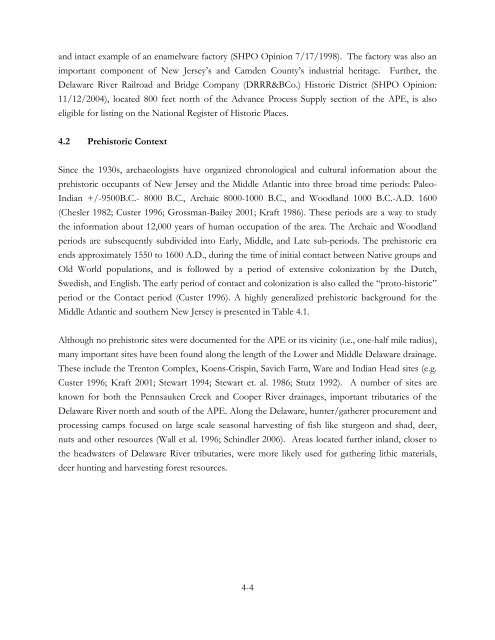APPENDIX D Cultural Resources Survey Report - US Environmental ...
APPENDIX D Cultural Resources Survey Report - US Environmental ...
APPENDIX D Cultural Resources Survey Report - US Environmental ...
Create successful ePaper yourself
Turn your PDF publications into a flip-book with our unique Google optimized e-Paper software.
and intact example of an enamelware factory (SHPO Opinion 7/17/1998). The factory was also an<br />
important component of New Jersey’s and Camden County’s industrial heritage. Further, the<br />
Delaware River Railroad and Bridge Company (DRRR&BCo.) Historic District (SHPO Opinion:<br />
11/12/2004), located 800 feet north of the Advance Process Supply section of the APE, is also<br />
eligible for listing on the National Register of Historic Places.<br />
4.2 Prehistoric Context<br />
Since the 1930s, archaeologists have organized chronological and cultural information about the<br />
prehistoric occupants of New Jersey and the Middle Atlantic into three broad time periods: Paleo-<br />
Indian +/-9500B.C.- 8000 B.C., Archaic 8000-1000 B.C., and Woodland 1000 B.C.-A.D. 1600<br />
(Chesler 1982; Custer 1996; Grossman-Bailey 2001; Kraft 1986). These periods are a way to study<br />
the information about 12,000 years of human occupation of the area. The Archaic and Woodland<br />
periods are subsequently subdivided into Early, Middle, and Late sub-periods. The prehistoric era<br />
ends approximately 1550 to 1600 A.D., during the time of initial contact between Native groups and<br />
Old World populations, and is followed by a period of extensive colonization by the Dutch,<br />
Swedish, and English. The early period of contact and colonization is also called the “proto-historic”<br />
period or the Contact period (Custer 1996). A highly generalized prehistoric background for the<br />
Middle Atlantic and southern New Jersey is presented in Table 4.1.<br />
Although no prehistoric sites were documented for the APE or its vicinity (i.e., one-half mile radius),<br />
many important sites have been found along the length of the Lower and Middle Delaware drainage.<br />
These include the Trenton Complex, Koens-Crispin, Savich Farm, Ware and Indian Head sites (e.g.<br />
Custer 1996; Kraft 2001; Stewart 1994; Stewart et. al. 1986; Stutz 1992). A number of sites are<br />
known for both the Pennsauken Creek and Cooper River drainages, important tributaries of the<br />
Delaware River north and south of the APE. Along the Delaware, hunter/gatherer procurement and<br />
processing camps focused on large scale seasonal harvesting of fish like sturgeon and shad, deer,<br />
nuts and other resources (Wall et al. 1996; Schindler 2006). Areas located further inland, closer to<br />
the headwaters of Delaware River tributaries, were more likely used for gathering lithic materials,<br />
deer hunting and harvesting forest resources.<br />
4-4

















